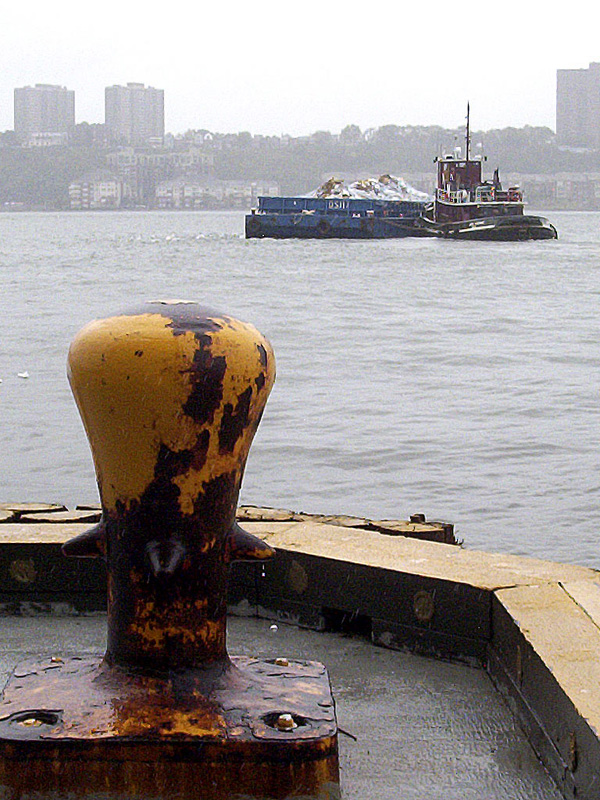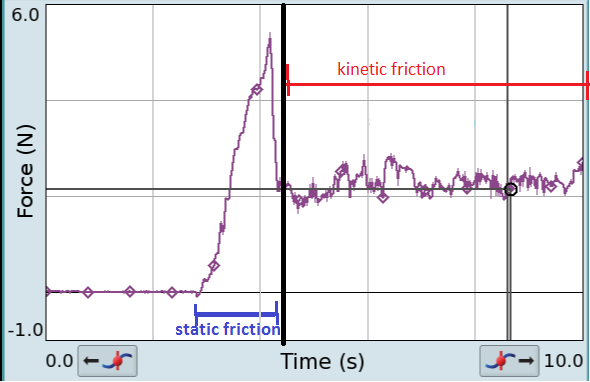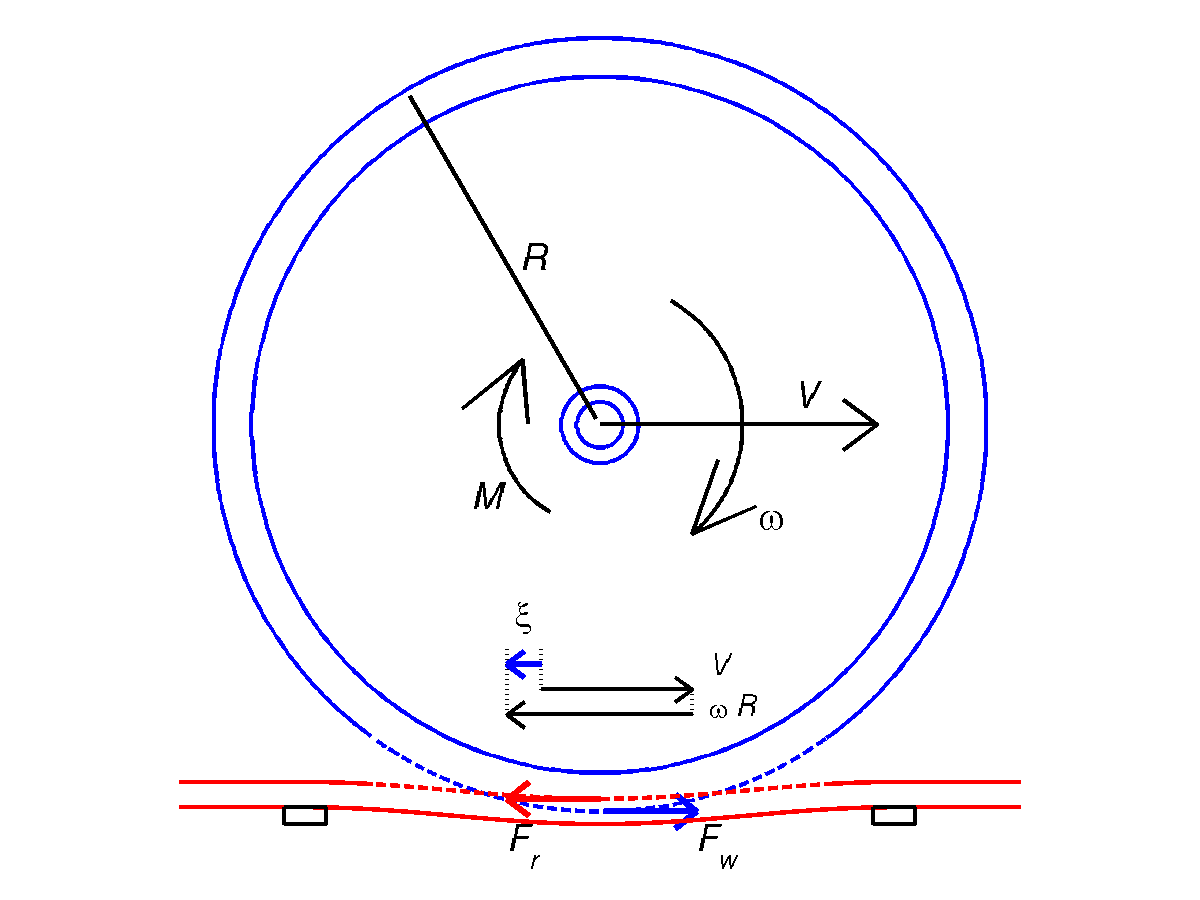|
Belt Friction
Belt friction is a term describing the friction forces between a belt and a surface, such as a belt wrapped around a bollard. When a force applies a tension to one end of a belt or rope wrapped around a curved surface, the frictional force between the two surfaces increases with the amount of wrap about the curved surface, and only part of that force (or resultant belt tension) is transmitted to the other end of the belt or rope. Belt friction can be modeled by the Belt friction equation. In practice, the theoretical tension acting on the belt or rope calculated by the belt friction equation can be compared to the maximum tension the belt can support. This helps a designer of such a system determine how many times the belt or rope must be wrapped around a curved surface to prevent it from slipping. Mountain climbers and sailing crews demonstrate a working knowledge of belt friction when accomplishing tasks with ropes, pulleys, bollards and capstans. Equation The equation used ... [...More Info...] [...Related Items...] OR: [Wikipedia] [Google] [Baidu] |
Belt (mechanical)
A belt is a loop of flexible material used to link two or more rotating Drive shaft, shafts mechanically, most often parallel. Belts may be used as a source of motion, to Transmission (mechanics), transmit power efficiently or to track relative movement. Belts are looped over pulleys and may have a twist between the pulleys, and the shafts need not be parallel. In a two pulley system, the belt can either drive the pulleys normally in one direction (the same if on parallel shafts), or the belt may be crossed, so that the direction of the driven shaft is reversed (the opposite direction to the driver if on parallel shafts). The belt drive can also be used to change the speed of rotation, either up or down, by using different sized pulleys. As a source of motion, a conveyor belt is one application where the belt is adapted to carry a load continuously between two points. History The mechanical belt drive, using a pulley machine, was first mentioned in the text the ''Dictionary of ... [...More Info...] [...Related Items...] OR: [Wikipedia] [Google] [Baidu] |
Bollard
A bollard is a sturdy, short, vertical post. The term originally referred to a post on a ship or quay used principally for mooring boats. It now also refers to posts installed to control road traffic and posts designed to prevent automotive vehicles from colliding or crashing into pedestrians and structures, whether intentional from ram-raids and vehicle-ramming attacks, or unintentional losses of control. Etymology The term is probably related to bole, meaning a tree trunk. The earliest citation given by the ''Oxford English Dictionary'' (referring to a maritime bollard) dates from 1844, although a reference in the ''Caledonian Mercury'' in 1817 describes bollards as huge posts. History Wooden posts were used for basic traffic management from at least the beginning of the 18th century. An early well-documented case is that of the "two oak-posts" set up next to the medieval Eleanor cross at Waltham Cross, Hertfordshire, in 1721, at the expense of the Society of Antiqua ... [...More Info...] [...Related Items...] OR: [Wikipedia] [Google] [Baidu] |
Tension (physics)
In physics, tension is described as the pulling force transmitted axially by the means of a string, a rope, chain, or similar object, or by each end of a rod, truss member, or similar three-dimensional object; tension might also be described as the action-reaction pair of forces acting at each end of said elements. Tension could be the opposite of compression (physics), compression. At the atomic level, when atoms or molecules are pulled apart from each other and gain potential energy with a restoring force still existing, the restoring force might create what is also called tension. Each end of a string or rod under such tension could pull on the object it is attached to, in order to restore the string/rod to its relaxed length. Tension (as a transmitted force, as an action-reaction pair of forces, or as a restoring force) is measured in newton (unit), newtons in the International System of Units (or pounds-force in Imperial units). The ends of a string or other object transmitt ... [...More Info...] [...Related Items...] OR: [Wikipedia] [Google] [Baidu] |
Capstan Equation
The capstan equation or belt friction equation, also known as Euler-Eytelwein's formula (after Leonhard Euler and Johann Albert Eytelwein), relates the hold-force to the load-force if a flexible line is wound around a cylinder (a bollard, a winch or a capstan). Because of the interaction of frictional forces and tension, the tension on a line wrapped around a capstan may be different on either side of the capstan. A small ''holding'' force exerted on one side can carry a much larger ''loading'' force on the other side; this is the principle by which a capstan-type device operates. A holding capstan is a ratchet device that can turn only in one direction; once a load is pulled into place in that direction, it can be held with a much smaller force. A powered capstan, also called a winch, rotates so that the applied tension is multiplied by the friction between rope and capstan. On a tall ship a holding capstan and a powered capstan are used in tandem so that a small force c ... [...More Info...] [...Related Items...] OR: [Wikipedia] [Google] [Baidu] |
Capstan (nautical)
A capstan is a vertical- axled rotating machine developed for use on sailing ships to multiply the pulling force of seamen when hauling ropes, cables, and hawsers. The principle is similar to that of the windlass, which has a horizontal axle. History The word, connected with the Old French ''capestan'' or ''cabestan(t)'', from Old Provençal ''cabestan'', from ''capestre'' "pulley cord," from Latin ''capistrum'', -a halter, from ''capere'', to take hold of, seems to have come into English (14th century) from Portuguese or Spanish shipmen at the time of the Crusades. Both device and word are considered Spanish inventions. Early form In its earliest form, the capstan consisted of a timber mounted vertically through a vessel's structure which was free to rotate. Levers, known as bars, were inserted through holes at the top of the timber and used to turn the capstan. A rope wrapped several turns around the drum was thus hauled upon. A rudimentary ratchet was provided to hold t ... [...More Info...] [...Related Items...] OR: [Wikipedia] [Google] [Baidu] |
Mass
Mass is an intrinsic property of a body. It was traditionally believed to be related to the quantity of matter in a physical body, until the discovery of the atom and particle physics. It was found that different atoms and different elementary particles, theoretically with the same amount of matter, have nonetheless different masses. Mass in modern physics has multiple definitions which are conceptually distinct, but physically equivalent. Mass can be experimentally defined as a measure of the body's inertia, meaning the resistance to acceleration (change of velocity) when a net force is applied. The object's mass also determines the strength of its gravitational attraction to other bodies. The SI base unit of mass is the kilogram (kg). In physics, mass is not the same as weight, even though mass is often determined by measuring the object's weight using a spring scale, rather than balance scale comparing it directly with known masses. An object on the Moon would weigh le ... [...More Info...] [...Related Items...] OR: [Wikipedia] [Google] [Baidu] |
Static Friction
Friction is the force resisting the relative motion of solid surfaces, fluid layers, and material elements sliding against each other. There are several types of friction: *Dry friction is a force that opposes the relative lateral motion of two solid surfaces in contact. Dry friction is subdivided into ''static friction'' ("stiction") between non-moving surfaces, and ''kinetic friction'' between moving surfaces. With the exception of atomic or molecular friction, dry friction generally arises from the interaction of surface features, known as asperities (see Figure 1). *Fluid friction describes the friction between layers of a viscous fluid that are moving relative to each other. *Lubricated friction is a case of fluid friction where a lubricant fluid separates two solid surfaces. *Skin friction is a component of drag, the force resisting the motion of a fluid across the surface of a body. *Internal friction is the force resisting motion between the elements making up a sol ... [...More Info...] [...Related Items...] OR: [Wikipedia] [Google] [Baidu] |
Radian
The radian, denoted by the symbol rad, is the unit of angle in the International System of Units (SI) and is the standard unit of angular measure used in many areas of mathematics. The unit was formerly an SI supplementary unit (before that category was abolished in 1995). The radian is defined in the SI as being a dimensionless unit, with 1 rad = 1. Its symbol is accordingly often omitted, especially in mathematical writing. Definition One radian is defined as the angle subtended from the center of a circle which intercepts an arc equal in length to the radius of the circle. More generally, the magnitude in radians of a subtended angle is equal to the ratio of the arc length to the radius of the circle; that is, \theta = \frac, where is the subtended angle in radians, is arc length, and is radius. A right angle is exactly \frac radians. The rotation angle (360°) corresponding to one complete revolution is the length of the circumference divided by the radius, which i ... [...More Info...] [...Related Items...] OR: [Wikipedia] [Google] [Baidu] |
Exponential Growth
Exponential growth is a process that increases quantity over time. It occurs when the instantaneous rate of change (that is, the derivative) of a quantity with respect to time is proportional to the quantity itself. Described as a function, a quantity undergoing exponential growth is an exponential function of time, that is, the variable representing time is the exponent (in contrast to other types of growth, such as quadratic growth). If the constant of proportionality is negative, then the quantity decreases over time, and is said to be undergoing exponential decay instead. In the case of a discrete domain of definition with equal intervals, it is also called geometric growth or geometric decay since the function values form a geometric progression. The formula for exponential growth of a variable at the growth rate , as time goes on in discrete intervals (that is, at integer times 0, 1, 2, 3, ...), is x_t = x_0(1+r)^t where is the value of at ... [...More Info...] [...Related Items...] OR: [Wikipedia] [Google] [Baidu] |
Orthotropic Material
In material science and solid mechanics, orthotropic materials have material properties at a particular point which differ along three orthogonal axes, where each axis has twofold rotational symmetry. These directional differences in strength can be quantified with Hankinson's equation. They are a subset of anisotropy, anisotropic materials, because their properties change when measured from different directions. A familiar example of an orthotropic material is wood. In wood, one can define three mutually perpendicular directions at each point in which the properties are different. It is most stiff (and strong) along the grain, because most cellulose fibrils are aligned that way. It is usually least stiff in the radial direction (between the growth rings), and is intermediate in the circumferential direction. This anisotropy was provided by evolution, as it best enables the tree to remain upright. Because the preferred coordinate system is cylindrical-polar, this type of orthotrop ... [...More Info...] [...Related Items...] OR: [Wikipedia] [Google] [Baidu] |
Friction Coefficient
Friction is the force resisting the relative motion of solid surfaces, fluid layers, and material elements sliding against each other. There are several types of friction: *Dry friction is a force that opposes the relative lateral motion of two solid surfaces in contact. Dry friction is subdivided into ''static friction'' ("stiction") between non-moving surfaces, and ''kinetic friction'' between moving surfaces. With the exception of atomic or molecular friction, dry friction generally arises from the interaction of surface features, known as asperities (see Figure 1). *Fluid friction describes the friction between layers of a viscous fluid that are moving relative to each other. *Lubricated friction is a case of fluid friction where a lubricant fluid separates two solid surfaces. *Skin friction is a component of drag, the force resisting the motion of a fluid across the surface of a body. *Internal friction is the force resisting motion between the elements making up a sol ... [...More Info...] [...Related Items...] OR: [Wikipedia] [Google] [Baidu] |
Frictional Contact Mechanics
Contact mechanics is the study of the deformation of solids that touch each other at one or more points. This can be divided into compressive and adhesive forces in the direction perpendicular to the interface, and frictional forces in the tangential direction. Frictional contact mechanics is the study of the deformation of bodies in the presence of frictional effects, whereas '' frictionless contact mechanics'' assumes the absence of such effects. Frictional contact mechanics is concerned with a large range of different scales. * At the macroscopic scale, it is applied for the investigation of the motion of contacting bodies (see Contact dynamics). For instance the bouncing of a rubber ball on a surface depends on the frictional interaction at the contact interface. Here the total force versus indentation and lateral displacement are of main concern. * At the intermediate scale, one is interested in the local stresses, strains and deformations of the contacting bodies in and ne ... [...More Info...] [...Related Items...] OR: [Wikipedia] [Google] [Baidu] |






